Iowa
Like other states along the Mississippi River, the first Europeans to arrive in Iowa were French. In 1673 during their expedition to explore the Mississippi, Louis Joliet and Pere Jacques Marquette made contact with the Illinois Indians in the east of modern day Iowa. The area became part of New France but remained primarily Indian territory with little European settlement. In 1803 it was bought by the USA as part of the Louisiana Purchase. The US built Fort Madison in 1808 to secure the area from the British and to control trade along the Mississippi. However, during the War of 1812 the fort was taken by Indians allied to the British. In 1829 the US government started to move Indian tribes from the fertile Mississippi valley, which ultimately triggered the Black Hawk War of 1832. After Black Hawk surrendered in Wisconsin, the US purchased the Mississippi valley lands from the Indian tribes and settlement began. Iowa Territory was created in 1838 and in 1846 Iowa became a US state with its capital at Iowa City. In 1857 the decision was taken to move the capital to the more central location of Des Moines. Most of Iowa is flat plains with giant fields and only huge grain silos to break the monotony of an otherwise featureless horizon. If you have read Bill Bryson’s book ‘The Lost Continent’ which covered his early life in Des Moines, you will be familiar with this description. In our travels we have stayed close to the Mississippi valley in the east where the scenery is slightly more interesting.
Mississippi at Dubuque
Until the railroads were developed the Mississippi was the prime transport route through the centre of North America and Dubuque quickly grew to become Iowa’s main port and riverboat stop. It is over 1600 km (1000 miles) to New Orleans but even this far north the Mississippi is an impressive sight and it is easy to imagine the days when the river was bustling with traffic. When we first visited Dubuque, we were pleasantly surprised to find a city with many historical buildings in an attractive location on the banks of the Mississippi, very different from the image that we had of Iowa.
Devonian Fossil Gorge, Coralville Dam
Around 375 million years ago this was the bottom of the ocean. Most of the inhabitants of the earth at that time lived in the oceans with only primitive plants and a few early creatures living on the land. It would be nearly another 200 million years before dinosaurs would roam the earth. When the creatures who lived in the ocean died they fell to the bottom where they became buried and then fossilised. In 1958 Coralville Dam was completed upstream of this site. Between July 5 and August 2, 1993 the dam overflowed via its spillway creating a raging torrent in the gorge below the dam, so powerful that it removed the vegetation, soil and some of the bedrock. The scouring of the water revealed rock that was rich with fossils from the Devonian era. The gorge quickly became a popular tourist attraction, but the rock is relatively soft so within 15 years erosion and heavy foot traffic had resulted in the obliteration of many of the visible fossils. Another major overflow from the dam in 2008 brought fresh fossils to the surface. Click Tab 2 to see a sample of the fossils found in the gorge,
DLU050923
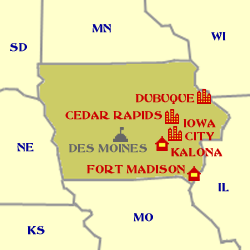
Click on Minimap to navigate
Typical farms near Kalona
Kalona is an interesting place, Amish and Mennonites live around it and it has some interesting museums. The area around it is also an excellent example of the scenery for which Iowa is most famous. Fields stretch out as far as the eye can see and the horizon is mainly flat except where it is punctuated by tall grain silos. You will not find high mountains in Iowa, but you will gain an insight into the rural mid-west of the USA.


We have more pages on Iowa. Click below or on the Minimap:

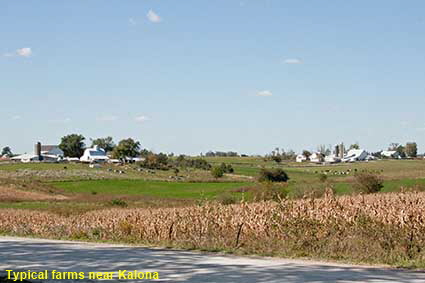
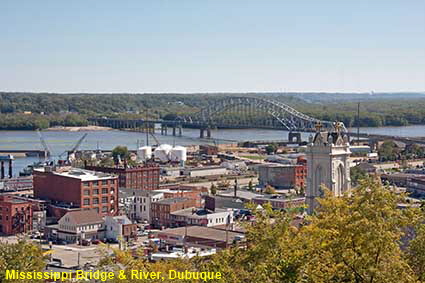
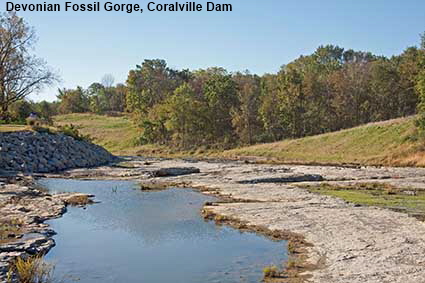
Phelps House Museum, Columbia Street at Snake Alley, Burlington
Burlington sits on the shores of the Mississippi some 265 km (165 miles) down river from Dubuque. In 1805, Lt. Zebulon Pike landed at the bluffs below Burlington and raised the United States Flag but nothing happened until 1829 when the American Fur Company built a trading post. Settlement began in 1833 and in 1837 Burlington became the second territorial capital of the Wisconsin Territory. When the Iowa Territory came into existence the following year, Burlington became its first capital. Burlington merchant William Garrett built a two storey home in 1851 at the top of the hill overlooking the downtown area and the river. Garrett became increasingly successful and in 1870 he significantly enlarged the house. The house with the Garrett and Phelps families until 1972. It is now a House Museum open for tours weekend afternoons May to October.
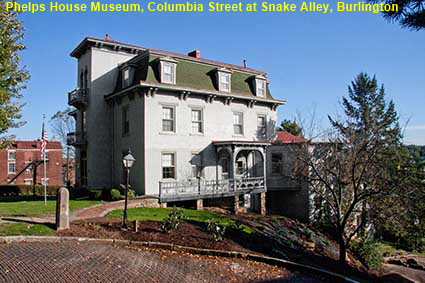
© Mike Elsden 1981 - 2023
The contents of this page may not be reproduced in full or in part without permission